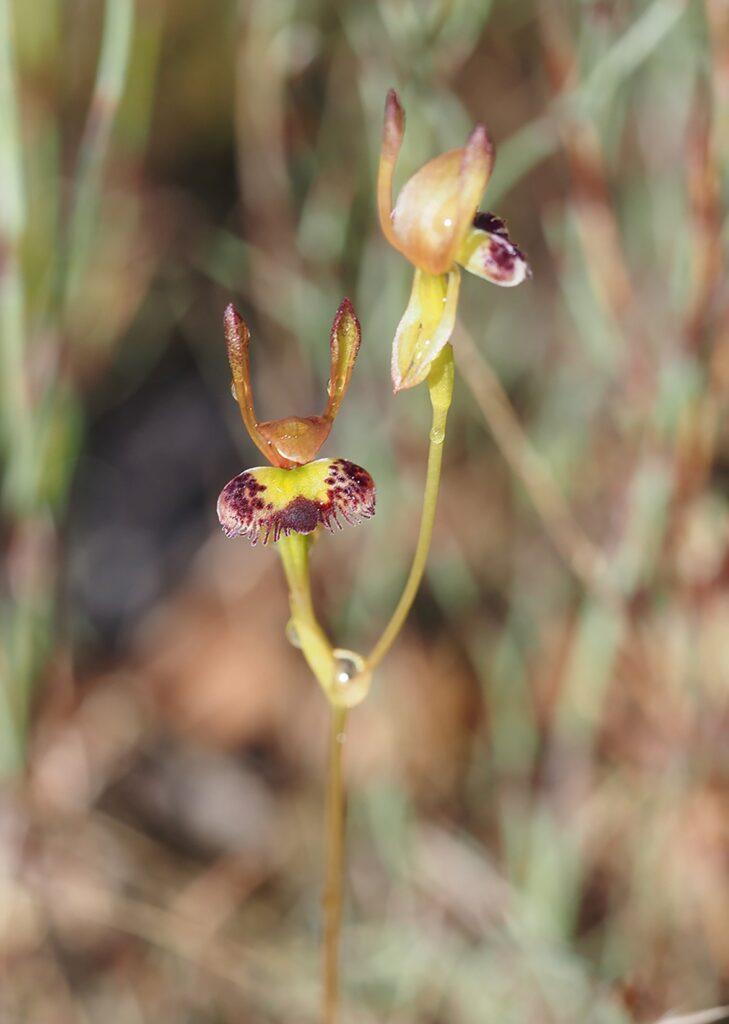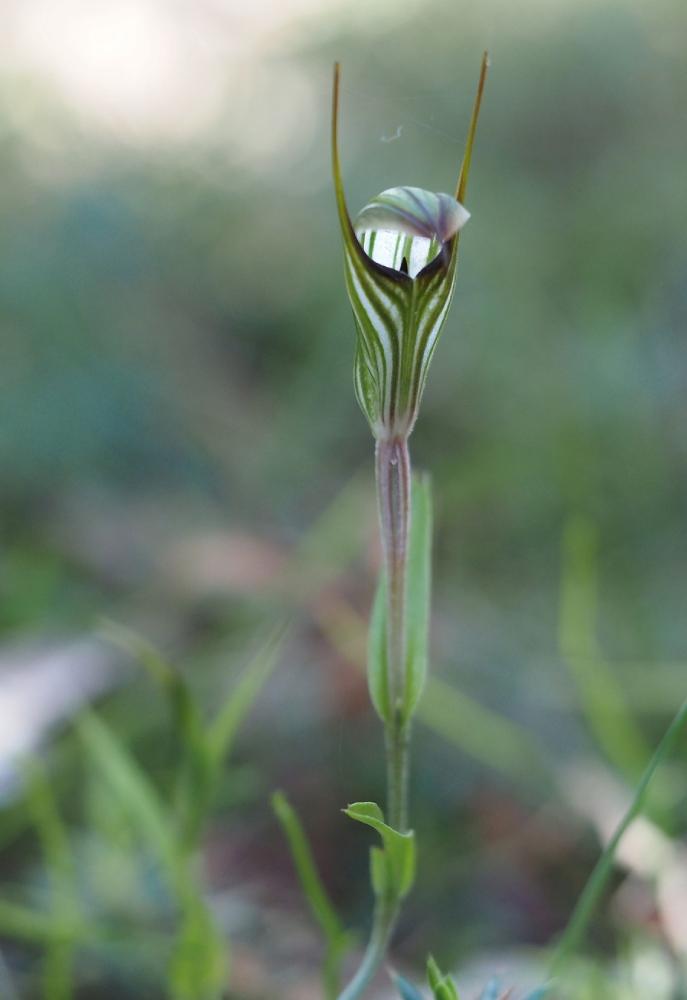With the autumn rains late in the season followed by the warm sunshine, the Anglesea heathlands are showing every promise of a good orchid season both for our winter and spring orchids.
The Fringed Hare Orchids, Leporella fimbriata, that we reported flowering in the second week of April are continuing to impress us with their attractive flowers. It is interesting to note that some colonies flower earlier than others. While the ones in the Alcoa Conservation Reserve have finished flowering, there are still some to see in other sites. As we said last month it is a matter of searching amongst the vegetation and treading carefully so as not to damage the orchids, many of which will often grow in the middle of bush tracks. We were thrilled to find some that had been pollinated, so it is exciting to know that the male winged ants, Myrmeciua urens, which are the recognised pollinator of the species, are active in our district. Colonies of ground-hugging, red-veined ovate leaves are appearing in the late flowering stage.

Fringed Hare Orchid
Greenhoods are a feature of the Anglesea district with 20 species recorded in the area. The Brown-tipped Greenhood, Pterostylis clivosa, that was documented in last month’s report has continued to flower with many fine specimens observed in mid-May.

Brown-tipped Greenhood
The Tiny Greenhood, P. parviflora, is not as common and not many flowers have been observed although there were plenty growing in loose colonies in the Fairhaven area. These two species often grow in close proximity and you need to look carefully to notice the different features as sometimes the Tiny Greenhood can be tinged with brown especially when it is finishing flowering.

Tiny Greenhood
One of our special species the Striped Greenhood, P. striata, is flowering very well on the Anglesea heathlands. We have just one known colony on public land of this attractive greenhood that has 3 to 6 leaves up the stem. Flowering plants do not have rosettes while non-flowering plants have a ground-hugging rosette of 4 to 10 small leaves.

Striped Greenhood
Another eye-catching greenhood is the Banded Greenhood, P. sanguinea, and we were pleased to find some in full flower in mid-May, with many just at the bud stage, The reddish-brown nodding flowers ensure that this greenhood is not confused with any other. Again it is the non-flowering plants that produce the rosettes.

Banded Greenhood
Trim Greenhoods, P. concinna, seem to have been just so grateful for the autumn rains, and very large colonies with tiny buds just starting to form have been observed, while carpets of the familiar Nodding Greenhood rosettes, P. nutans, are appearing throughout the district. It should be a spectacular flowering season for them. Tall Greenhoods, P. melagramma, are also putting up quite well-developed flowering stems ready for flowering in winter and spring.
Small Mosquito Orchids, Acianthus pusillus, are appearing in large numbers with their small insect-like flowers looking quite beautiful especially if they catch the sunlight. A small hand lens allows you to see the features of the tiny flowers. The orchid forms large colonies of heart-shaped leaves, green on top, purplish below.

Mosquito Orchid
Leaves of other orchids are also starting to appear: Gnat Orchids, Cyrtostylis sp. Waxlips, Glossodia major, and sun orchids, Thelymitra sp. The hairy leaves of our spider orchids are also sure to be making their presence known.
Winter is the time for our Helmet Orchids, Corybas sp., to flower, with the first ones Small Helmet Orchid, Corybas unguiculatus, usually appearing in June, followed by Veined Helmet Orchids, C. diemenicus, and then the Slaty Helmet Orchids, C. incurvus.
Please let us know of any of your orchid discoveries. We are always keen to know where our orchids are growing.
All of our orchids are documented and photographed in Orchids of the Anglesea District. The new edition costing $30.00 is available from the Angair Natural History Centre on Monday and Thursday mornings, online through the Angair website and from Anglesea News & Lotto and Great Escape Books in Aireys Inlet.
Margaret MacDonald margmacmoggs@icloud.com Alison Watson alisonw577@gmail.com